
Cottonwoods, boxelder and willow along the Laramie River at Fort Laramie, on a hot day in 2016.
In southeast Wyoming, on the Laramie River just above the confluence with the North Platte, Fort Laramie still rises from the prairie. From its beginnings in the 1830s as a private fur-trading post, until the US military abandoned it in 1890, it was the most important outpost on the Northern Plains. Trappers, traders, Indians, emigrants, gold miners, soldiers and settlers all came here—for commerce, supplies, advice, news, negotiations, peace-making and war. For many, it was their only connection to the civilized but hostile world back East.
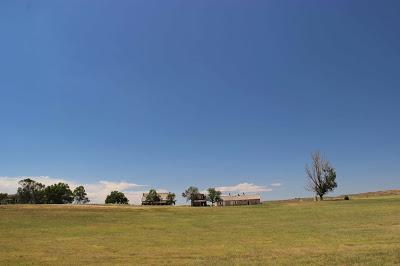 In 1849, the US Government bought the property from the American Fur Company to establish a US Army post, in part to make clear to Britain and Mexico that this was United States territory. The most important mission was protecting the tens of thousands of west-bound travelers who passed through each year on the Oregon/California Trail—probably the largest single land migration in history.
In 1849, the US Government bought the property from the American Fur Company to establish a US Army post, in part to make clear to Britain and Mexico that this was United States territory. The most important mission was protecting the tens of thousands of west-bound travelers who passed through each year on the Oregon/California Trail—probably the largest single land migration in history.Most emigrants had “jumped off” at the Missouri River, and had been on the trail for over a month when they reached Fort Laramie. They averaged on the order of just 15 miles per day in the sweltering heat of the Great Plains, breathing dust churned up into great clouds by hooves, wagon wheels and human feet. The Fort was a welcome layover—a place to rest and fatten livestock, wash clothes, and repair wagons. It was one of the few places on the long journey to buy supplies.

Fort Laramie was about a third of the way from the Missouri River to the coast (source).
In the early 1850s, some 50,000 travelers were arriving at Fort Laramie each year! The total between 1841 and 1866 may have been 350,000, or as high as 500,000. These numbers speak to how difficult and dangerous life was for many people in the early days of our country. More than a few had lost everything to events beyond their control. What else could they do but leave, in hopes of something better? We were fortunate to have the huge sparsely-populated West and all it promised.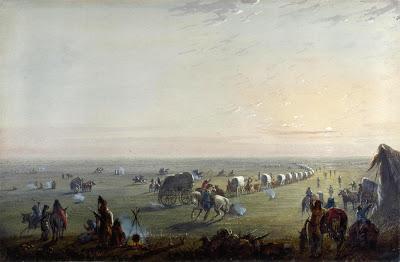
Immigration—ever the hopeful path to a better life. Painting by Alfred Jacob Miller (wikimedia).
My first visit to Fort Laramie was in July 1999, to prepare a vegetation map for the National Historic Site. It was hot! One afternoon while surveying open rolling country covered in sagebrush and grass, we came upon deep wagon ruts. They were overgrown but still obvious—remains of the Oregon Trail. Standing in the broiling sun, I looked down on the Laramie River several miles away, and was struck by how blessed and inviting its lush green gallery forests must have appeared to early travelers.
But I was wrong. There were no trees along the river at Fort Laramie during the great migration, no shade to soothe weary souls. They had been cut down years earlier, for buildings and fuel.
My misguided historical imaginings fell apart last week, when I returned to the Fort and saw this photo:

Crow delegation at the Fort Laramie council site in 1868 (from park interpretive sign).
Fort Laramie was an important council site. Indians set up camp on a large flat area across the Laramie River, and prominent tribal leaders—Smoke, Red Cloud, Man Afraid of His Horses, Spotted Tail—met and negotiated with representatives of the US Government. Today, an interpretive sign near the river explains: “The ridgeline in this image [above] can still be seen if one looks east across the Laramie River.” But one has to look carefully to spot any landmarks, as the council site is now largely hidden from view by trees.
Should trees blocking the historical view be cut down? (arrows mark points on ridge visible in old photo)
In the absence of trees, what was used for fuel? I asked the friendly historian at the Visitor Center, who explained that the Army had a timber reservation on Laramie Peak 50 miles to the west; there was a lumber mill nearby. Soldiers were detailed to cut wood, and haul milled lumber and firewood back to the Fort. Though it was nice to get away—tedium and boredom being the biggest problems at Fort Laramie—it was dangerous. Lieutenant Levi P. Robinson met his end on a wood-cutting detail, killed by Indians. (Though there were skirmishes nearby, the fort itself was never attacked, being large and well-defended.)When the Army closed Fort Laramie in 1890, trees were returning to the river. A century later, with cottonwood groves well established, a debate arose: if there were no trees during the historical period of interest, do today’s interfere with re-creation of those times?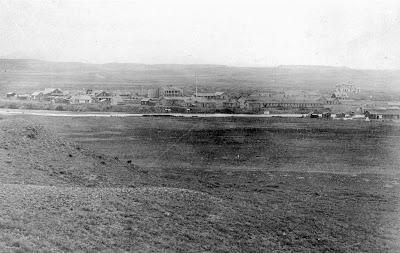
Fort Laramie in 1875, viewed from across the tree-less Laramie River (source).

Fort Laramie in 1889, a year before it was abandoned. Trees line part of the river (source).
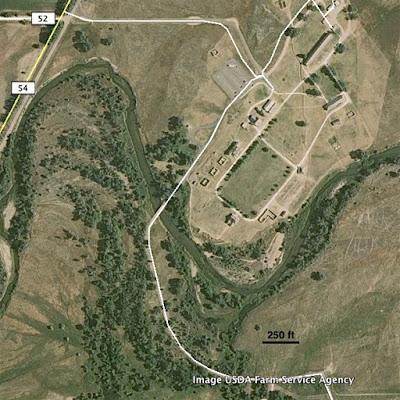
Fort Laramie in 2009, with cottonwood, boxelder and willow along the river (Google Earth).
In 1980, historian Merrill J. Mattes argued in defense of historical accuracy:“… need to have proper understanding and respect for the Fort's historic setting as well as its buildings. Over the decades the persistent efforts to plant parade ground trees which never existed during the "period of maximum importance," and to defend the post-1890 cottonwood grove along the river from any historical vista clearing … suggest that Park Service planners and managers have never been overly concerned with the sanctity of the historical setting.” (Mattes 1980; italics added).I have to admit, the "cottonwood grove along the river” definitely confused my interpretation of the historical setting! It was more harsh than I had imagined. Perhaps some trees could be cleared to restore the historical view of the council site, but I think it would be fine to leave the rest. Last week, with temperatures in the 90s, I happily took a break in the shade of cottonwood trees along the river. It didn’t diminish at all my appreciation for how tough those early travelers were!
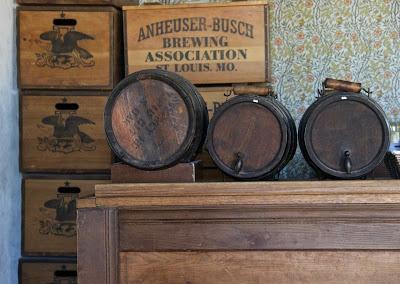 During our mapping project in 1999, we often took our lunch break in the saloon, cooled by an electric fan. “I’ll have a cold sas’sprilla” I’d say, pounding my fist on the bar in true Western style. Did soldiers and emigrants at Fort Laramie really have the option of an ice cold drink in the sweltering heat of midday? Most likely not, but I was sure glad we did!
During our mapping project in 1999, we often took our lunch break in the saloon, cooled by an electric fan. “I’ll have a cold sas’sprilla” I’d say, pounding my fist on the bar in true Western style. Did soldiers and emigrants at Fort Laramie really have the option of an ice cold drink in the sweltering heat of midday? Most likely not, but I was sure glad we did! On my return visit last week, I again headed over to the saloon, pounded my fist on the bar, and said, “I’ll have a cold sas’sprilla.” The bartender obliged. It was just as refreshing as I remembered.
On my return visit last week, I again headed over to the saloon, pounded my fist on the bar, and said, “I’ll have a cold sas’sprilla.” The bartender obliged. It was just as refreshing as I remembered.
Fort Laramie National Historic Site is open year-round, no charge. Dogs are allowed on leash (outside). Summer days are hot, but maybe that’s the best time to visit if you want the real emigrant experience (peak visitation back then was late May to early July).• • •
 This is my contribution to the July gathering of tree-followers, kindly hosted by The Squirrelbasket. In lieu of following a specific tree (too much work and travel), I’m posting about trees, at least for a few more months.Sources
This is my contribution to the July gathering of tree-followers, kindly hosted by The Squirrelbasket. In lieu of following a specific tree (too much work and travel), I’m posting about trees, at least for a few more months.SourcesBuck, R. 2015. The Oregon Trail. Highly recommended (The New York Times agrees).Mattes, MJ. 1980. Fort Laramie park history 1834-1977. National Park Service. Last updated 2003; available here.National Park Service. 2014. Fort Laramie brochure. Available at the park.Old photos, drawings and other images of Fort Laramie are available here (no charge for non-commercial use). Unfortunately there’s little information about the scenes and sources.
